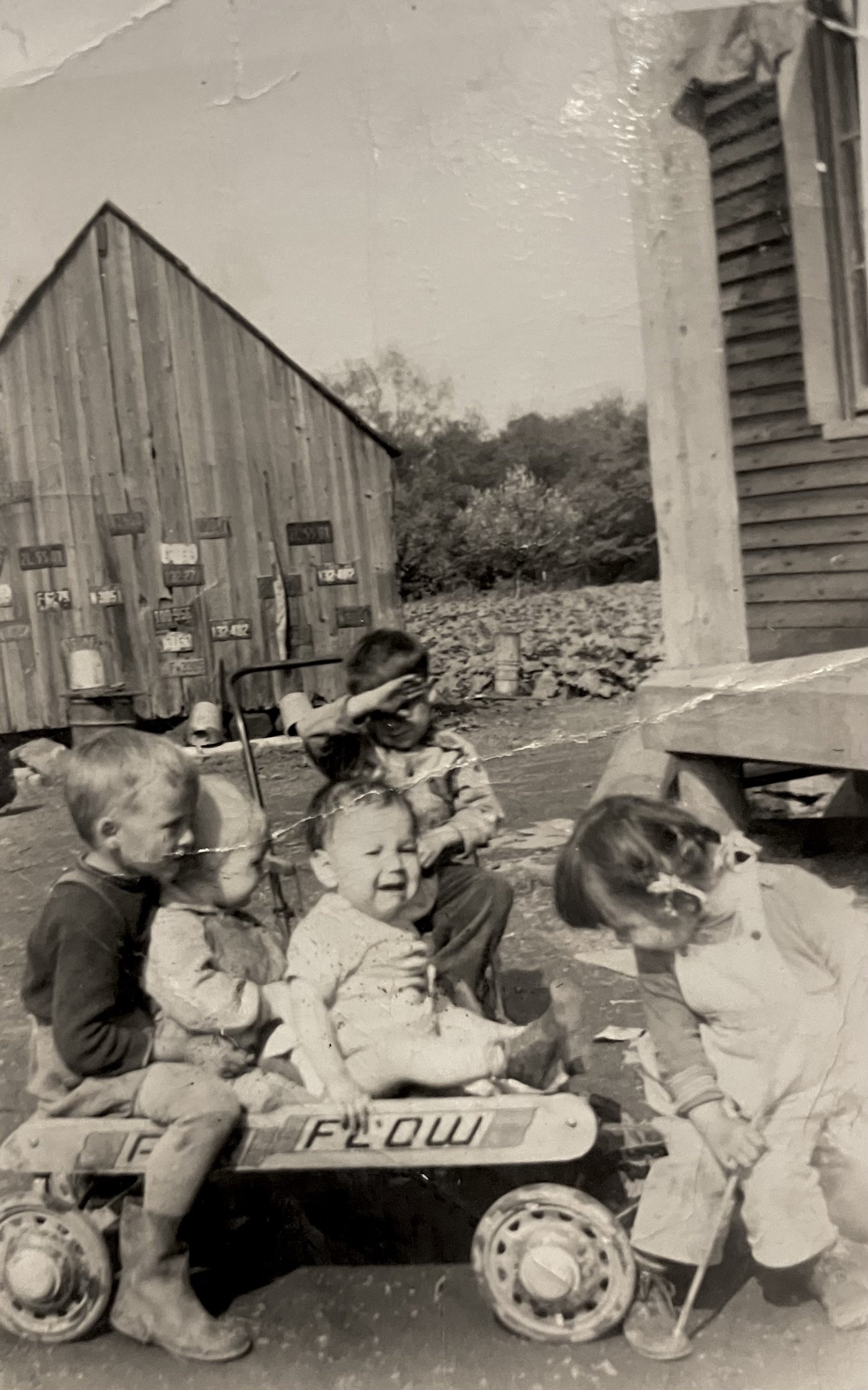Rhubarb fields
Leonard Atonnion Bordeau sits at the front of a wagon. Two children from the neighbourhood sit to his left. Behind Leonard is his cousin Steven Cross and to the right is his sister Marie Cross. Behind them are the rhubarb fields at the Bordeau farm. (Courtesy: Leonard Atonnion Bordeau)
Story told by Leonard Atonnion Bordeau
I grew up on a farm, the Bordeau farm, which was in the family since the 1800s.
My late grandfather, he passed in 1948, somehow had secured a contract with Nathan Steinberg of the Steinberg chain of grocery stores. He had to fill a quota of a truckload of produce every day.
We had fields and fields of rhubarb. So he would hire people from town to come to the farm and pick rhubarb all day long. They would cut off the big leaf and bunch them up with a rubber band and load it up on the truck.
My grandfather would take it to a warehouse somewhere in the city.
The workers were being paid, I think maybe 25 cents an hour, but they were fed. My late grandmother would be working before a very hot stove to feed them.
As the years went by, the demand for rhubarb got maybe a little bit less, or maybe was too expensive. The workers wanted more money so at one point, they gave them more but they had to bring their own lunch. It was because my late grandma was getting older and it was too much work for her to be cooking over a hot stove in July.
Somewhere around 1955, there were rumours going around that the St. Lawrence Seaway was coming through. With that, the rhubarb just died out at a certain point.
Teiohontahiò:tsis kaiénthon
Leonard’s aunt, Susan Bordeau, pictured with one of her daughters in front of the rhubarb fields on the Bordeau farm. Photo taken in 1942. (Courtesy: Leonard Atonnion Bordeau)
Leonard Atonnion Bordeau roká:raton
Kahehtà:ke tewakatehià:ron, nè:’e ne Bordeau tsi thatiienthótha’. 1800 shiiohseratátie’ kahwatsí:rakon shikaientà:’on. Rakhsotkénha, 1948 shiiohserò:ten’ wahatóhetste’, ronaterihwahseronníhne’ ne Nathan Steinberg né:ne Steinberg tsi thontenhninòn:tha’. Teiotonhontsóhon ska’seréhta ahá:nahne’ ne sewenhnísera.
Ionkwahehtakà:tehkwe’ ne teiohontahiò:tsis. Né: ká:ti’ kanatakonhró:non wahshakóhnha’ne’ ne aontahón:ne’ tánon’ ahatí:ko’ ne teiohontahiò:tsis. Enhatí:ia’ke’ ne kanerahtowá:nen’s tánon’ enhatirò:roke’ sok ohnatiróntha’ enhatihwánerenke’ tánon’ ka’seréhtakon enhonnetárion’.
Ka’k nón: ne Tiohtià:ke tsi ionteweien’tónhkhwa’ tsi kanónhsote’ ienháhawe’ ne rakhsótha’.
Ronatkarià:ki ne rotiió’te’, kwah í:kehre’ 25 sén:ts ronatkarià:ki ne énksa enkahwistà:’eke’, nek tsi ronwatí:nontens nen’ nè:’e. Akhsotkénha tiótkon shes karistákta iakokhón:ni.
Tsi ontohseróhetste’, ton’serón:nenhte’ tsi ní:kon wa’tewatonhóntsohwe’ ne teiohontahiò:tsis, tóka’ nòn:wa ò:ni’ sótsi wa’kanó:ron’ne’. Tánon’ tsi na’á:wen’ne rotiió’te wahatiri’wanón:ton’ ne ísi’ nón: ahonatkária’khse’, tahonwatí:ion’ nen’ nè:’e, nek tsi ronónha ó:nen’k tsi tahontén:na’te’ . Ase’kén akhsotkénha taiakoienta’onhátie’ tánon’ sótsi kaio’tenhserowá:nen ne karistákta aiakokhonníhake’ ne Ohiarihkó:wa niwenhni’tò:ten’.
Ka’k nón: ákta 1955 shiiohserò:ten’, karihontienóntie’skwe’ tsi enhonnón:ni’ tsi kana’tsheratátie’ ne Kaniatarowanèn:ne. Né: káti’ eh karátie’, kwató:ken’k nikarì:wes onterihwáhton’ tsi ratiiénthos ne teiohontahiò:tsis.
Edited by: Emma McLaughlin, Local Journalism Initiative Reporter
Translation by Sahawisó:ko’ Arquette


